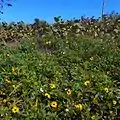Helianthus debilis
Helianthus debilis is a species of sunflower known by the common names cucumberleaf sunflower, beach sunflower, weak sunflower,[2] and East Coast dune sunflower.[3] It is native to the United States, where it can be found along the Atlantic and Gulf Coasts.[4] It is known elsewhere as an introduced species, such as South Africa, Australia, Taiwan, Slovakia, and Cuba.[5]
| Helianthus debilis | |
|---|---|
.jpg.webp) | |
| Scientific classification | |
| Kingdom: | Plantae |
| Clade: | Tracheophytes |
| Clade: | Angiosperms |
| Clade: | Eudicots |
| Clade: | Asterids |
| Order: | Asterales |
| Family: | Asteraceae |
| Genus: | Helianthus |
| Species: | H. debilis |
| Binomial name | |
| Helianthus debilis | |
| Synonyms[1] | |
| |
This species may be an annual or perennial herb.[4] It is usually perennial but it may last only one season in climates where freezes occur.[6] It can reach a height of 2 meters. The stem grows from a taproot and may grow erect or decumbent.[4] It can also spread along the ground, becoming a dense groundcover.[6] The leaves are usually arranged alternately and are variable in shape and size. The largest are up to 14 centimeters long by 13 wide. The showy inflorescence is a single flower head or an array of two or three heads. There are up to 30 lance-shaped phyllaries each up to 1.7 centimeters long. There are up to 20[4] or 21[7] ray florets, each up to 2.3 centimeters long. They are usually yellow in the wild, but cultivars have been bred to bear whitish,[7] reddish, or orange florets.[6] The center of the head is filled with many red, yellowish,[4] or purplish[7] disc florets. The fruit, a cypsela, is roughly 2 or 3 millimeters long.[4]
There are several subspecies. At one point there were eight.[8] Five are currently recognized.[1][4]
- Helianthus debilis subsp. cucumerifolius - cucumberleaf sunflower. The subspecies with the widest distribution.[5][9]
- Helianthus debilis subsp. debilis - beach sunflower. Endemic to Florida.[10][11]
- Helianthus debilis subsp. silvestris - forest sunflower. Endemic to Texas.[12][13]
- Helianthus debilis subsp. tardiflorus - slow-flowering sunflower. Mississippi to Florida.[14][15] Limited to rare, specialized coastal habitat.[16]
- Helianthus debilis subsp. vestitus - clothed sunflower,[17] hairy beach sunflower.[18] Endemic to Florida.[19] Imperiled; known from about 22 occurrences.[18]
This species grows in several types of coastal habitat, sometimes directly on the beach. It tolerates a moderately saline environment, but not an excessive amount of salt spray or inundation.[20] It is highly drought-tolerant and it will grow in low-nutrient and poor soils, such as alkaline and acidic soils and sand.[6][7] The plant attracts butterflies and birds feed on the fruits.[6]
This plant is used as a garden flower. It is also good for landscaping, especially in poor, dry soils. It is planted on beaches, where it forms a sand-binding groundcover that prevents erosion and stabilizes dunes.[21] It requires supplemental watering only rarely, if ever. It may get "ratty-looking" after the showy flowers have withered.[20] Available cultivars include 'Italian White',[7] 'Flora Sun',[21]'Dazzler', 'Excelsior', and 'Orion'.[6]
Gallery
Dune Sunflowers growing in Miami Beach sand dunes (South Beach)
 Sea Grapes and Dune Sunflowers
Sea Grapes and Dune Sunflowers Dune Sunflower Closeup
Dune Sunflower Closeup
References
- The Plant List, Helianthus debilis Nutt.
- "Helianthus debilis". Germplasm Resources Information Network. Agricultural Research Service, United States Department of Agriculture. Retrieved 21 January 2018.
- Wunderlin, R. P. and B. F. Hansen. 2008. Helianthus debilis. Atlas of Florida Vascular Plants. Institute for Systematic Botany, University of South Florida, Tampa.
- Helianthus debilis. Flora of North America.
- "Helianthus debilis subsp. cucumerifolius". Germplasm Resources Information Network. Agricultural Research Service, United States Department of Agriculture. Retrieved 21 January 2018.
- Gilman, E. F. and S. Park-Brown. Helianthus debilis Beach Sunflower. Environmental Horticulture, Florida Cooperative Extension Service, Institute of Food and Agricultural Sciences, University of Florida. 1999. Revised 2007.
- Christman, S. Helianthus debilis. Floridata.com. 1999. Updated 2003.
- Wain, R. P. (1983). Genetic differentiation during speciation in the Helianthus debilis complex. Evolution 37(6) 1119-27.
- Helianthus debilis ssp. cucumerifolius. Flora of North America.
- "Helianthus debilis subsp. debilis". Germplasm Resources Information Network. Agricultural Research Service, United States Department of Agriculture. Retrieved 21 January 2018.
- Helianthus debilis ssp. debilis. Flora of North America.
- "Helianthus debilis subsp. silvestris". Germplasm Resources Information Network. Agricultural Research Service, United States Department of Agriculture. Retrieved 21 January 2018.
- Helianthus debilis ssp. silvestris. Flora of North America.
- "Helianthus debilis subsp. tardiflorus". Germplasm Resources Information Network. Agricultural Research Service, United States Department of Agriculture. Retrieved 21 January 2018.
- Helianthus debilis ssp. tardiflorus. Flora of North America.
- Helianthus debilis ssp. tardiflorus. NatureServe.
- "Helianthus debilis subsp. vestitus". Germplasm Resources Information Network. Agricultural Research Service, United States Department of Agriculture. Retrieved 21 January 2018.
- Helianthus debilis ssp. vestitus. NatureServe.
- Helianthus debilis ssp. vestitus. Flora of North America.
- Gann, G. D., et al. 2005-2013. East Coast dune sunflower Helianthus debilis. Natives For Your Neighborhood. The Institute for Regional Conservation. Delray Beach, Florida, USA.
- Maura, C. and S. Sanders. Helianthus debilis ssp. debilis Plant Fact Sheet. USDA NRCS Brooksville Plant Materials Center. 2002.
